Montpelier in the Dirt
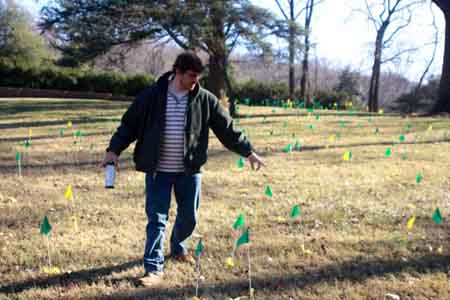
(Archeologist Matt Greer points out the yellow and green flags that represent positive and negative hits from metal detectors operated by volunteers with thirty years experience. Matt is once of the resident interns at Montpelier and the son of an old shipmate and a great young man. He has completed his master’s degree in the archeological study of slavery. He will start his PhD program at Syracuse in the fall, so a chance to walk the grounds of the estate with someone who has played in the dirt drew us back to the plantation on a magnificent Virginia day. I asked him what they dug up about slavery in New York State, and he shrugged. “They don’t have many good programs in the South. I don’t think they like to talk about it,” he said.)
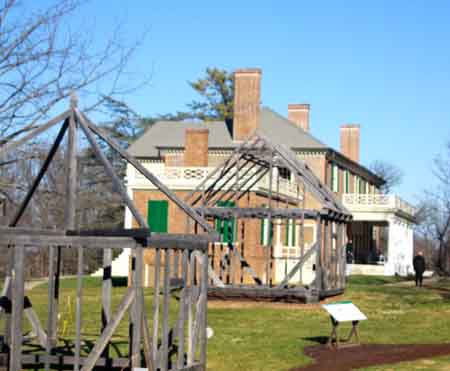
Matt waked us through the fruit of previous archeological digs conducted since the 1990s. The skeletons of the structures represent the outlines of the original slave quarters, smoke houses and kitchen literally outside Mother Madison’s private quarters.
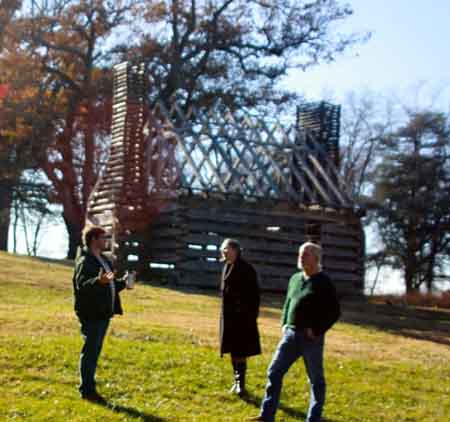
The wooden chimneys are an authentic feature of the slave quarters, tiny duplex structures that may represent James Madison’s attempt to put a humane face on the peculiar institution. Our guide opined that guests from Europe and the North visiting Thomas Jefferson’s magnificent Monticello often later complained about the harsh treatment of the chattel residents of Jefferson’s estate.
It is possible that the placement and design of the structures adjacent to Montpelier was an attempt to show how slave management could be benign for those subject to bondage- a sort of slave Potemkin Village. Behind the cabin is the former stable complex, now completely gone but revealed by concentrations of nails and other building material below the grass.
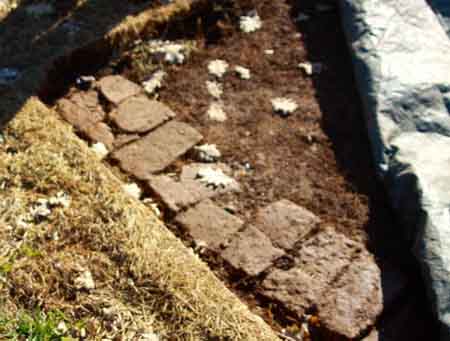
This brickwork, unearthed by the archeological team, and currently covered by a protective tarp, was part of a drain that ran through the slave quarters and was possibly connected to a cistern fed by a pipeline routed from a bubbling spring north of the garden patch, now replaced by Marion DuPont’s formal garden. There are plans for a return in the spring when the Virginia soil erupts with new growth.
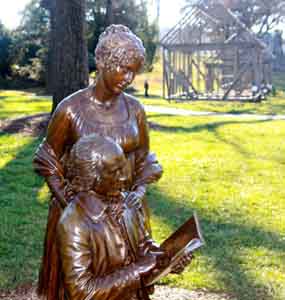 

This exquisite life-sized statue of President Madison and his lovely wife Dolley is a feature of the yard immediately behind the rear portico of the mansion. The tour was surreal. I took the mansion tour last Sunday, a day as beautiful as this, and the emphasis was on the former First Family, their life and times, and the restoration of the place from the splendor of the DuPont century to something that approximates 1830, when the Madisons were in retirement at Montpelier.
Looking at the bones of the bones left under the soil, and archeological survey has a larger focus- on the entirely of the plantation experience. By all accounts, Madison was a fair master and administered discipline through private counseling. Yet the contrast between the high rhetoric of the Father of the Constitution and the stark reality of the institution that made his Montpelier possible results in a sense of cognitive dissonance.
I looked from behind to see what James was reading to Dolley. I know it is only a sculpture, but the page is blank metal.
As part of the program of excavations, identification of slave graves, and general public sentiment about digging in the dirt resulted in outreach to African American descendants of the Montpelier slave family. A reporter from one of the local mullet-wrappers approached an older African-American man at his small farm. He looked up expectantly, saying “You’ve come about the owl, haven’t you?”
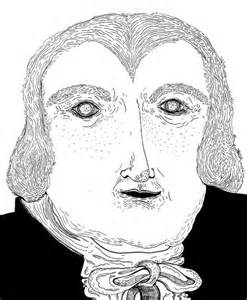
He went on to explain that President Madison had appeared on his property in the incarnation of an owl, and roosted in his barn. He opined that he had no problems with Montpelier or anyone digging on it. He did say that he didn’t think anyone should stay in the mansion at night, since the “click, click, click” of Dolley Madison’s heels on the wooden floors would keep them awake.
Matt the archeologist believed that conveyed the communal memory about who wielded the discipline in the Madison household.
There was almost too much to absorb. We toured the cellars- the “back of the house” of Montpelier, with the poured clay floors, concealed floor compartments to store valuable ash for the making of soap, and the secure store rooms for the valuable spices and wine. And the holes in the floor where a bottle of wine might be slipped under the wall to be retrieved later, when Dolley wasn’t looking.
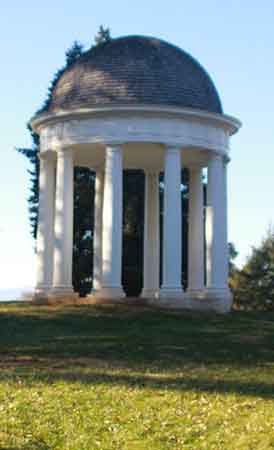
Outside again, we walked across the spot where the west-side kitchen outbuilding had stood, and down to the ice-house, a 19-foot deep underground storage facility capped by a graceful Doric temple structure. Matt commented that it was intended to convey the high civilization and soaring freedom of the classical age.
“Built by slaves, right?” I asked. Matt nodded.
Matt took us down the hill and pointed at a valley a bit wistfully. “We call that Dolley’s Midden. It is where all the trash and garbage where thrown in the Madison years. We have only excavated a fraction of it. There is all sorts of stuff- pottery, animal bones- from the time of her occupancy. I would like to get permission to dig there again.”
Then we strolled past some DuPont-era structures that included a power-plant to run the electrical lights on the plantation after they took possession of the estate in 1901. Montpelier was the first electrically lit place in the County, and was completely independent on any power grid. Money is a cool thing. There is a DuPont bowling alley in the complex, which young Matt thinks should get his historical attention.
Then we were ushered further down the hill and into the Archeological Laboratory, housed in . A couple young women were rinsing dirt from gravel and possible artifacts on the porch, and inside was a host of reconstructed bottles, china and artifacts from the Civil War days at the plantation, which Stonewall Jackson occupied as winter quarters in the winter of 1863-64.
We had been walking and talking for hours, and the shadows were starting to lengthen. We bade farwell at the lab and trudged back up the hill, behind the mansion, through the slave village, the stable complex and back to the Visitor’s Center to saddle up in the Panzer.
“One last thing I would like to see- Madison’s grave,” I said, and Mattski and Natasha agreed. We parked by the side of the gravel lane and walked up the pasture to the Madison Graveyard.
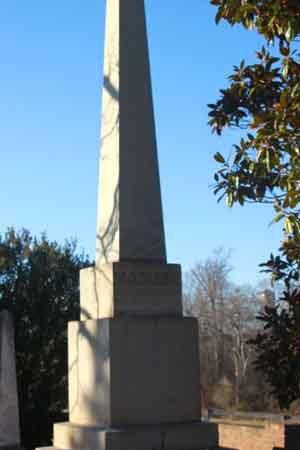
“The DuPonts were kind of amazing,” said Mattski. “They bought the remains of the fourth President of the United States.”
“And his whole family,” I said. I took some pictures of the faded inscriptions and the imposing but pare obelisk that marks the president’s grave. Dolley’s is much more modest, and dutifully to the President’s side.
It was a great tour of Montpelier’s dirt, and the secrets that it conceals so well.
Copyright 2014 Vic Socotra
www.vicsocotra.com
Twitter: @jayare303
The complete photo shoot is at my Facebook page. Montpelier is worth a visit- the formal history in the residence, and the completely informal history that rests with James and Dolley Madison under the soil.
